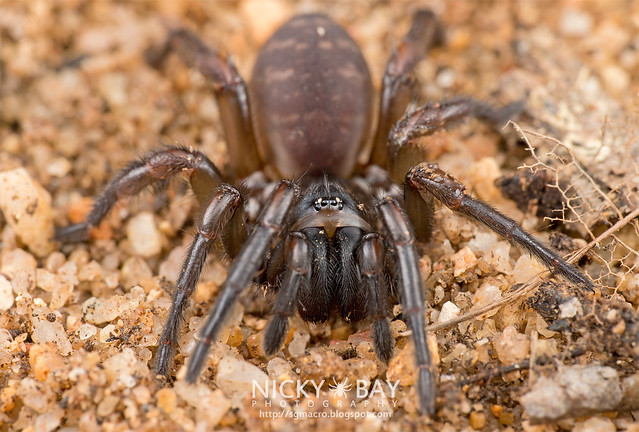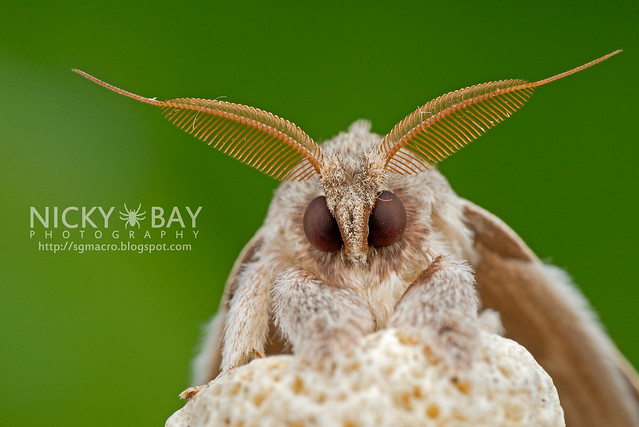Nikoi Island [ Day 1 | Day 2 | Day 3 ]
I had the opportunity to do an arthropod survey in Nikoi Island, a private resort island located 8km east of Bintan. It is a beautiful little island (probably about 400-500m from east to west), but the little patch of undisturbed forest has never been observed up close. Exploring the unknown could reveal many interesting bugs, but we could also return home with nothing. Nevertheless, we proceeded with much anticipation!
To find out more about Nikoi Island, visit their website or Facebook page. It takes just 2.5 hours from Singapore to reach Nikoi Island (1 hour on ferry, 1 hour on taxi, 20 minutes on private ferry).
Behind the scenes photos courtesy of James and my Galaxy S4. :)
Nikoi Island [ Day 1 | Day 2 | Day 3 ]
The complete album for Day 1 can be viewed here.
I had the opportunity to do an arthropod survey in Nikoi Island, a private resort island located 8km east of Bintan. It is a beautiful little island (probably about 400-500m from east to west), but the little patch of undisturbed forest has never been observed up close. Exploring the unknown could reveal many interesting bugs, but we could also return home with nothing. Nevertheless, we proceeded with much anticipation!
To find out more about Nikoi Island, visit their website or Facebook page. It takes just 2.5 hours from Singapore to reach Nikoi Island (1 hour on ferry, 1 hour on taxi, 20 minutes on private ferry).
Behind the scenes photos courtesy of James and my Galaxy S4. :)
- The initial journey on the private cab in Bintan seemed uneventful, with hardly any cars on the road.
- We requested for a quick stop when we passed by a traditional fishing village
- Sunning the fish
- View of the private jetty that brings us to Nikoi Island!
- Only 2 of us boarding the boat. It was that private.
- Bye bye Bintan!
- How the boat looks from inside. Very comfortable but we couldn't sit still
- Nikoi Island in sight!
- Approaching the little jetty
- They had these to cycle our luggage to the rooms
- Had a glimpse of level 1 of our cabin - these are the owners' rooms so if you are looking to stay at Nikoi, your rooms should look way more awesome!
- The most important part of the room... given that we are going to be trudging through the greenery :)
- Checked out the toiletries :P
- Saw a Signal Fly (Platystomatidae) taking a breather and I took a warm-up shot of the beautiful eyes
- Before our first jungle walk, we went to the dining area to have our lunch
- James didn't take much prawns.. so these were all mine!!!
- Documenting the food. The owner of the island, Andrew was seated just behind James.
- Looks pretty clean, but its macro, we can find bugs anywhere!
- If you spot some whitish little bugs scurrying around on the sand, it is likely to be this Wolf Spider (Lycosidae)
- There were also many Tiger Beetles (Cicindelinae) hovering about, these guys are fast!! Interestingly, we showed the photos to some of the staff who had worked there for many years, but none have observed them up close yet!
- Only managed a few shots before the Tiger Beetle (Cicindelinae) flew off
- Checking out some of the tiny spiders along the sandy path
- And it's a Mesh Weaver Spider (Dictynidae) tending to her spiderlings!
- The Mesh Weaver Spider (Dictynidae) is typically brightly coloured with a hairy abdomen
- The spiderlings of the Mesh Weaver Spider (Dictynidae) looked quite cute!
- James found another bunch of Lynx Spider (Oxyopidae) babies
- Pointed Palmfly larva (Elymnias penanga) Many guests probably noticed the butterflies, but not the caterpillars.
- Looked under the leaves, and found a lovely green Comb-Footed Spider (Theridiidae) carrying her eggs
- Even when disturbed, she does not leave her eggs easily
- The Jumping Spiders (Salticidae) seem rather common here, but most were very small!
- We found many Feather-Legged Spiders (Uloboridae) on the plants. These spiders may tend to congregate or exhibit social behavior.
- This Crab Spider (Thomisidae) was seated very comfortably under a leaf. Almost impossible to spot it without looking really hard.
- The crab spider typically has exceptionally long fore legs
- A closer look at the Crab Spider's face
- Another tiny Jumping Spider (Salticidae)
- A male Orb Web Spider (Araneidae)
- The male Orb Web Spider (Araneidae) is typically much smaller than the female, with a shorter life span too
- A black Orb Web Spider (Araneidae) that looked like a black dot under a leaf
- Found a freshly hatched brood of Daddy-Long-Legs Spiderlings! (Pholcidae)
- The mother of the cute little brood. Daddy-Long-Legs Spider (Pholcidae)
- The Daddy-Long-Legs Spider (Pholcidae) tends to flatten it's body on the leaf surface when at rest, probably to hide itself.
- That's how cute some of the Jumping Spiders (Salticidae) can be!
- A Crab Spider (Thomisidae) climbed onto my finger!
- Placed the Crab Spider (Thomisidae) back onto the leaf
- One of the many Feather-Legged Spiders (Uloboridae)
- Feather-Legged Spider (Uloboridae)
- Feather-Legged Spider (Uloboridae)
- Found a Eucharitid Wasp (Eucharitidae) with combed antenna, but it didn't stay long enough for me to take more shots!
- Spot the 2 Feather-Legged Spiders (Uloboridae) in this picture!
- When the Feather-Legged Spiders (Uloboridae) were closer together
- Maybe the one on the left is female, and the other a male, but we couldn't confirm as they may not be fully mature yet.
- Closer look at the Feather-Legged Spider (Uloboridae)
- Most were found dangling on their web
- A young Common Mormon larva (Papilio polytes) which seems to mimic bird droppings
- Almost fully grown Common Mormon larva (Papilio polytes)
- The head of the Common Mormon larva (Papilio polytes) has patterns to mimic eyes of a larger bug to scare away some potential predators
- View of the full body of the Common Mormon larva (Papilio polytes)
- Big-Jawed Spider (Tetragnathidae), quite a common sight here as well.
- That's James peering around for bugs
- Nephilengys sp., often found on tree trunks or crevices of rocks
- The Two-Tailed Spider (Hersiliidae) has 2 extended spinnerets that earned its name
- The most unexpected find of the day was this Tube Trapdoor Spider (Nemesiidae) which we found in a small clearing full of golden orb weavers. It typically hides in burrows, so arachnophobes need not fear meeting up with them.
- Full view of the Tube Trapdoor Spider (Nemesiidae)
- It was surprising to find this Tube Trapdoor Spider (Nemesiidae) because it does not balloon (i.e. air travel) and they could either be on this island since long long ago, or brought in via timber or plants?
- Lovely specimen of the Tube Trapdoor Spider (Nemesiidae) indeed
- The eyes of the Tube Trapdoor Spider (Nemesiidae) rest on a raised area on the carapace
- The Tube Trapdoor Spider actually stopped on a leaf long enough for me to carry it for closeup shots!
- As night falls, we found a number of Scoliid Wasps (Scoliidae) sleeping on twigs
- The Scoliid Wasps (Scoliidae) were so deep in sleep that I could go that close to them!
- This is the typical sleeping position I guess
- We soon reached the mangroves and went down the shore to have a look. James found quite a number of Cryptic Sea Stars
- The Sea Stars had different patterns
- This Cryptic Sea Star is particularly unique because it has 7 legs instead of 5!!
- On our way back, there were a few Land Hermit Crabs (Coenobita sp.) walking along with us
- We went back to look at the Mesh Weaver Spider (Dictynidae) again!
- We tried setting up a light trap to see what interesting bugs would come to us.. but had little luck
- A cute Puppy Moth did come visiting us though!
- The Puppy Moth has a beautiful fanned/combed antennae
- There were more Scoliid Wasps (Scoliidae)
- This Scoliid Wasp (Scoliidae) seemed to be cleaning it's antennae
- Did it just wake up and see me!??!
- The rock surfaces had some Nephilengys sp.
- There I am taking shots of that spider
- And the result!
- A very distinctly coloured Two-Tailed Spider (Hersiliidae)
- Beautiful Derbid Planthopper (Derbidae), quite a common sight at night
- Comb-Footed Spider (Theridiidae) found a signal fly for supper!
- A smaller Crab Spider (Thomisidae) compared to the one we saw earlier
- This Two-Tailed Spider (Hersiliidae) had brighter colours, possibly moulted recently
- Found a Daddy-Long-Legs Spider (Pholcidae) carrying her egg sac!
- A happy Sac Spider (Clubionidae) found her meal for the night too
- James spotted some of these Spitting Spiders (Scytodidae) on a tree trunk
- The Spitting Spider (Scytodidae) spits venomous sticky mass at it's prey. How cool is that!
- Spitting Spider (Scytodidae) hanging around at the nest
- Male Orb Web Spider (Araneidae)
- Yet another Two-Tailed Spider (Hersiliidae) with prey. Many of these spiders are nocturnal and come out to hunt at night.
- Our first Huntsman Spider (Sparassidae) on the island!
- Looks like it is also having a nice supper
- Female Orb Web Spider (Neoscona sp.). We found several variants of this genus on the island.
- Clearer view of the abdomen
- Close up on the eyes
- We brought a large Nephilengys sp. down on a white surface to document
- The distinct character of Nephilengys sp. would be the micro-spines on the carapace as seen in this picture!



































































The day walk was not too bad, with the Tube Trapdoor Spider as our star find. After a quick dinner, we were out in the wild again!




































With hundreds of pictures in the first day.. we decided to get a good rest, and check out the sunrise the next day from the mangroves. Turned out that we didn't really have much time to sleep after all!! Check out the photos from Day 2 here.
Nikoi Island [ Day 1 | Day 2 | Day 3 ]
The complete album for Day 1 can be viewed here.